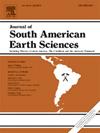Unveiling terrane boundaries and basin geometries through satellite gravity field derivatives in the central region of Argentina
IF 1.5
4区 地球科学
Q3 GEOSCIENCES, MULTIDISCIPLINARY
引用次数: 0
Abstract
Geodynamic and tectonic processes along the western margin of Gondwana during the Cretaceous, led to fragmentation of this supercontinent, and to the formation of South America and Africa as the South Atlantic opened. This complex event also affected paleo-terrane suture zones within the South American continent leading to the formation of a series of NNW intracratonic sedimentary depressions across central Argentina. The emplacement of these paleo-cratonic blocks has been described by V. A. Ramos (e.g. Ramos 1988; 1999; Ramos and Vujovich 1993; Ramos et al. 2010; 2014a; 2014b; 2020). His work has been crucial to the understanding of the tectonic processes and has also been referenced by numerous studies analysing terrane boundaries and basin distribution. Yet, the regional-scale geometry and location of the boundaries between the terranes, as well as of the depressions, based on geophysical data are scarce and/or remain imprecise. Combined Earth gravity field models derived from satellite and terrestrial data have been used to accurately map terrane boundaries and basin geometries (Braitenberg et al. 2011; Alvarez et al., 2012; Mariani et al. 2013; Christianse et al., 2021). The homogeneous data coverage of the GOCE (Gravity field and steady-state Ocean Circulation Explorer) derived models (Bruinsma et al. 2013) and the high resolution of the EIGEN-6C4 (European improved Gravity model of the Earth by New technics) model (Förste et al. 2014), which combines GOCE satellite data and terrestrial acquired data, allowed mapping at a larger scale with higher resolution and improved precision. We used in this work the Gravity Disturbance (Gd) and the Vertical Gravity Gradient (Tzz) data sets from both Earth gravity models to highlight basin geometries and different terranes boundaries in central Argentina. Both data sets were corrected by the effect of topography. The Gd were corrected by sedimentary load. The geologic features highlighted by the gravity derivatives match the terrane-cratonic block emplacement proposal of Ramos et al. (2010) for the central region of Argentina. Our interpretation of the Río de La Plata Craton (RPC) borders agree with the proposals of Rapela et al. (2011) and Oyhantçabal et al. (2011) regarding the eastern and western borders. However, significant differences are observed in the northern and southern borders.
通过阿根廷中部地区的卫星重力场衍生品揭示地体边界和盆地几何形状
白垩纪冈瓦纳西部边缘的地球动力学和构造过程,导致了这个超大陆的分裂,并在南大西洋打开时形成了南美洲和非洲。这一复杂事件也影响了南美大陆的古陆块缝合带,导致一系列横跨阿根廷中部的NNW克拉通内沉积坳陷的形成。这些古克拉通块体的侵位已被V. A. Ramos描述过(例如Ramos 1988;1999年;拉莫斯和武约维奇1993;Ramos et al. 2010;2014年;2014 b;2020)。他的工作对理解构造过程至关重要,也被许多分析地体边界和盆地分布的研究所引用。然而,基于地球物理数据的区域尺度几何和地体之间边界以及洼地的位置是稀缺和/或仍然不精确的。基于卫星和地面数据的地球重力场组合模型已被用于精确绘制地表边界和盆地几何形状(Braitenberg et al. 2011;Alvarez et al., 2012;Mariani et al. 2013;Christianse et al., 2021)。GOCE(重力场和稳态海洋环流探索者)衍生模型(Bruinsma等人,2013年)的均匀数据覆盖和EIGEN-6C4(欧洲新技术改进地球重力模型)模型(Förste等人,2014年)的高分辨率,结合了GOCE卫星数据和地面获取的数据,可以在更大的尺度上以更高的分辨率和更高的精度进行制图。在这项工作中,我们使用了来自两个地球重力模型的重力扰动(Gd)和垂直重力梯度(Tzz)数据集来突出阿根廷中部的盆地几何形状和不同的地体边界。两组数据均通过地形的影响进行了校正。通过沉积载荷对Gd进行了校正。重力导数所突出的地质特征与Ramos et al.(2010)对阿根廷中部地区的地-克拉通块体侵位建议相匹配。我们对Río de La Plata克拉通(RPC)边界的解释与Rapela et al.(2011)和oyhantabal et al.(2011)关于东西边界的建议一致。然而,在北部和南部边界观察到显著差异。
本文章由计算机程序翻译,如有差异,请以英文原文为准。
求助全文
约1分钟内获得全文
求助全文
来源期刊

Journal of South American Earth Sciences
地学-地球科学综合
CiteScore
3.70
自引率
22.20%
发文量
364
审稿时长
6-12 weeks
期刊介绍:
Papers must have a regional appeal and should present work of more than local significance. Research papers dealing with the regional geology of South American cratons and mobile belts, within the following research fields:
-Economic geology, metallogenesis and hydrocarbon genesis and reservoirs.
-Geophysics, geochemistry, volcanology, igneous and metamorphic petrology.
-Tectonics, neo- and seismotectonics and geodynamic modeling.
-Geomorphology, geological hazards, environmental geology, climate change in America and Antarctica, and soil research.
-Stratigraphy, sedimentology, structure and basin evolution.
-Paleontology, paleoecology, paleoclimatology and Quaternary geology.
New developments in already established regional projects and new initiatives dealing with the geology of the continent will be summarized and presented on a regular basis. Short notes, discussions, book reviews and conference and workshop reports will also be included when relevant.
 求助内容:
求助内容: 应助结果提醒方式:
应助结果提醒方式:


